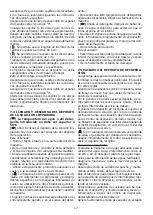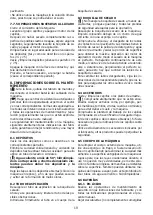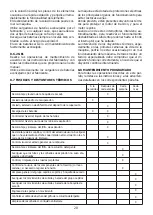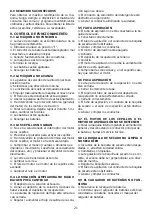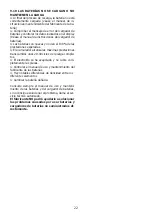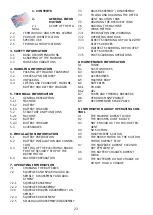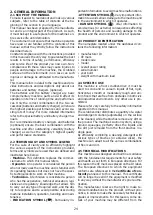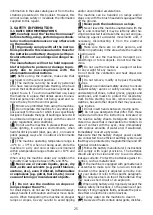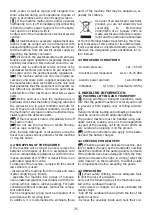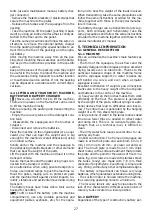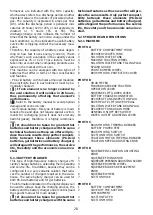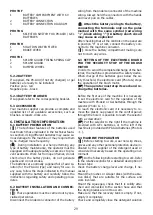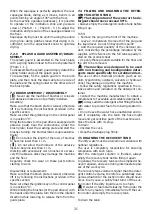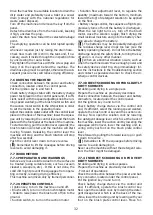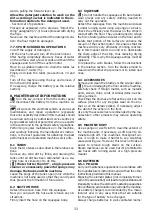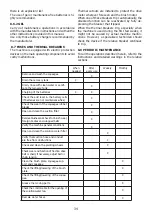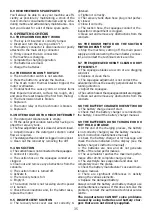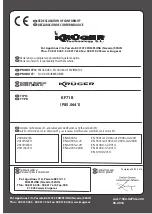
release control.
Fill the detergent solution tank with a mix of clean
water and non-foaming detergent in an adequate
concentration through the anterior hole. Leave 2
cm between the mouth of the plug and the level of
the liquid.
(
☞
)
To avoid risks, become familiar with the ma-
chine movements, carrying out test runs on a large
surface without obstacles.
To obtain the best results in terms of cleaning and
equipment service life, you should do the following
simple but important operations:
- Identify the work area, moving all possible obsta-
cles out of the way; if the surface is very extensive,
work in contiguous and parallel rectangular areas.
- Choose a straight work trajectory and begin wor-
king from the farthest area to avoid passing over
areas that have already been cleaned.
7. OPERATING INFORMATION
7.1 BATTERY CHARGING
Prepare and check the battery charge according to
the instructions provided in the specific section.
Detach the battery connector from the machine
power connector (the one with the gripping fins)
and connect the battery connector to the battery
charger connector.
(
!
)
Do not connect the battery charger to the
scrubber-drier’s main wiring connector.
Hold the connectors with the hands; do not pull
them using the cables.
If the machine is equipped with
Pb-Acid batte-
ries
, charge only in a well-ventilated area, lift the
superior cover and open the battery plugs.
(
)
Follow the steps indicated in the battery ma-
nufacturer’s operating and safety manual (see the
battery maintenance section).
If the machine is equipped with
gel batteries
(maintenance free), follow the instructions indica-
ted here below.
If the machine is used regularly:
Always keep the batteries connected to the battery
charger when the machine is not being used.
If the machine is not used for extended time periods:
Charge the battery during the night after the last
work period, then disconnect the battery from the
battery charger.
Charge the battery during the night before using
the machine again.
Intermediate or incomplete charging while working
should be avoided.
If the machine is equipped with Pb-Acid batteries,
use a hydrometer to check the element liquid in-
tensity on a regular basis: if one or more elements
are discharged and the others fully charged, the
battery has been damaged and should be replaced
or repaired (refer to the battery service manual).
Close the element plugs and lower the superior
cover.
Hold the connectors with the hands; don’t pull
them using the cables.
Reconnect the machine connectors.
7.2 SQUEEGEE AND SPLASH GUARD ASSEM-
BLY, DISASSEMBLY AND ADJUSTMENT
The squeegee is the main component that ensures
perfect drying.
7.2.1 SQUEEGEE ASSEMBLY
Lower the lifting system to avoid having to keep the
body raised while completing connections.
Loosen the connection knobs on the squeegee sup-
port (Photo D - 2).
Insert the openings of the squeegee body in the
brackets of the oscillating support.
Fully tighten the squeegee knobs of the support
(Photo D - 2) in order to block the squeegee on the
support.
Firmly insert the machine suction hose into the
squeegee body (Photo D - 7).
7.2.2 SQUEEGEE DISASSEMBLY
Lower the lifting system to avoid having to keep the
body raised while completing connections.
Disconnect the suction hose from the squeegee
body (Photo D - 7).
Loosen the connections connection knobs on the
squeegee support (Photo D - 2).
Pull back the squeegee body to detach it from the
brackets of the oscillating support.
7.2.3 SQUEEGEE BLADES REPLACEMENT
Disassemble the squeegee from its support (see
7.2.2)
Unscrew the knobs ( Photo D - 5 ), remove the
bolts and the metal bar holders of the squeegee
blades.
Remove the rubber blades from the squeegee body.
To assemble the new blades, place the metal bar
holders on the front blade; place them on the
squeegee body and insert the bolts in the holes of
the squeegee body.
Place the rear blade on the squeeegee body with
the the bolts in its holes; place the metal bar hol-
ders and block the blades screwing the fixing knobs
( Photo D - 5 ).
It’s normal that the rear strap has to be extended
to centre the connection screws. This will bring it
under the correct tension to avoid folds on the floor
and dry correctly.
7.2.4 SQUEEGEE ADJUSTMENT
The knob screw on the squeegee support (Photo
D - 1 ) adjust the squeegee’s inclination with re-
spect to the floor. The two screws on the sides, con-
nected to the rear wheels of the squeegee (Photo
D - 3 ), are to adjust the pressure of the squeegee
to the floor.
30
Summary of Contents for KF71B
Page 3: ...3 3 1 2 8 7 6 5 4 5 2 4 7 3 1 A B 9 6 8 10 ...
Page 4: ...4 4 3 1 5 6 1 2 3 4 4 3 2 5 6 5 6 C D 7 2 ...
Page 5: ...5 E 2 1 4 3 ...
Page 6: ...6 F G 2 2 1 Gel Acid 1 3 ...
Page 7: ...7 H 1 2 1 2 3 I ...


